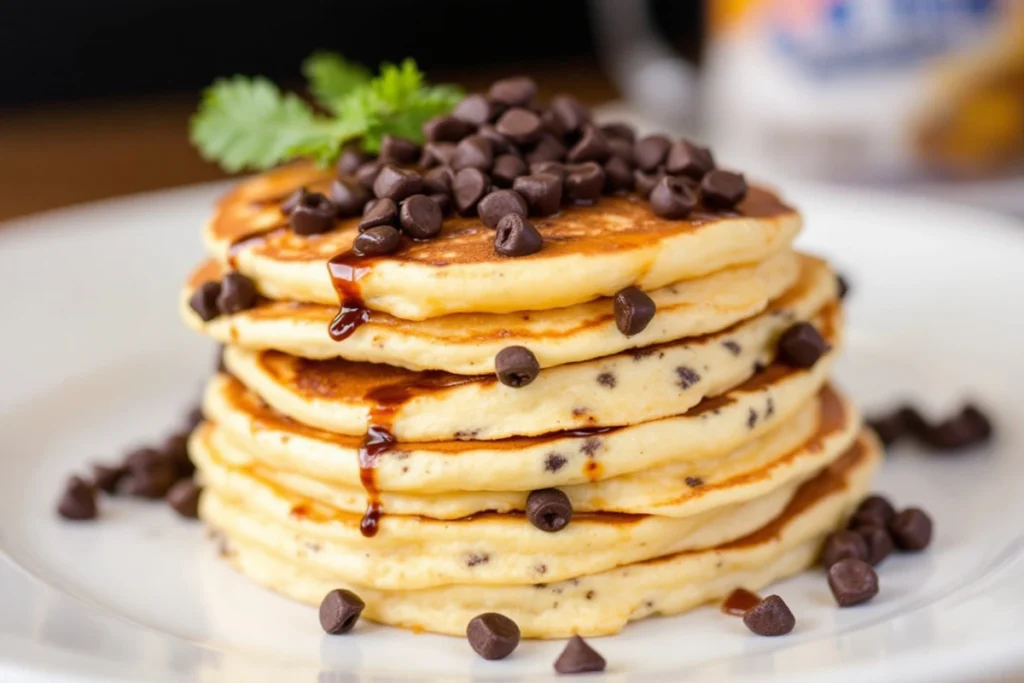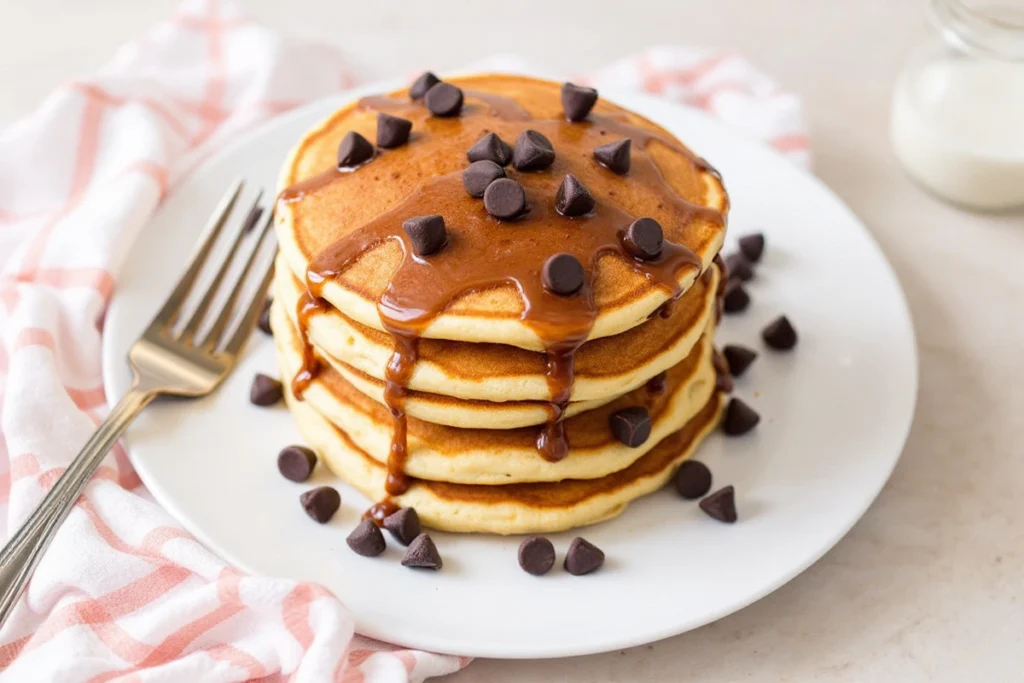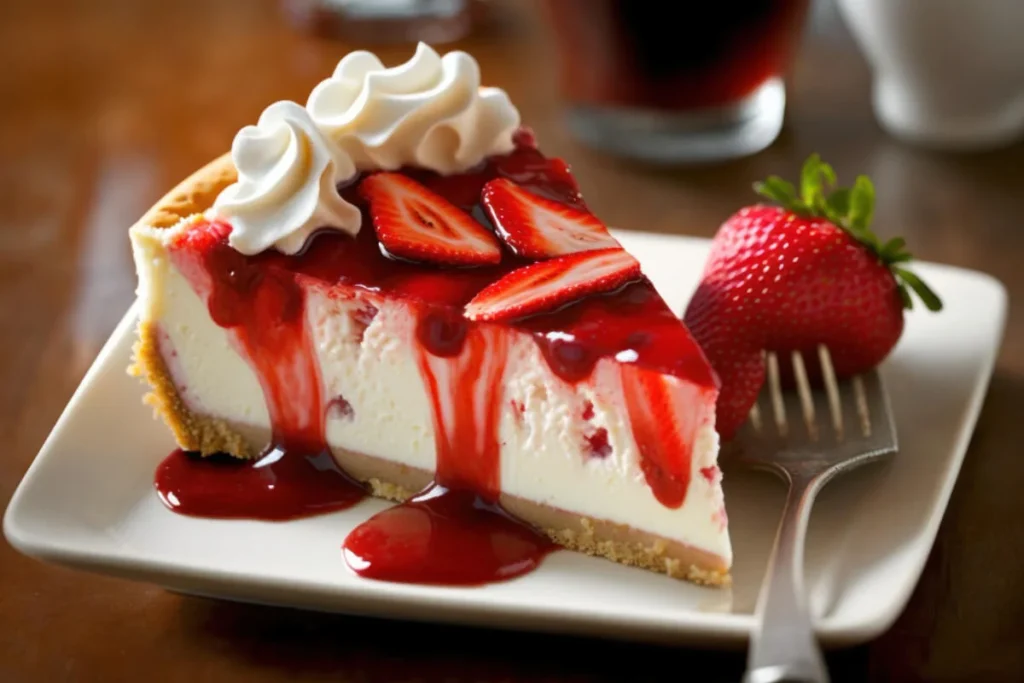
Introduction
Why Fluffy Pancakes Are a Breakfast Staple
Fluffy pancake are a quintessential breakfast favorite, loved for their light and airy texture that pairs perfectly with a variety of toppings. They offer a comforting, indulgent start to the day and are endlessly versatile, appealing to both traditionalists and creative food lovers alike.
The Science Behind Fluffiness
The fluffiness of pancakes depends on the formation of tiny air pockets in the batter, which expand during cooking. Key factors like fresh leavening agents, proper ingredient ratios, and minimal mixing help trap air, resulting in soft and lofty pancakes.
Essential Ingredients
Key Ingredients for Fluffy Pancakes
- Flour: All-purpose flour is most commonly used, but you can also experiment with cake flour for extra lightness.
- Baking Powder: Acts as the leavening agent to create air pockets.
- Eggs: Provide structure and richness.
- Milk or Buttermilk: Buttermilk adds tanginess and reacts with baking powder for extra fluffiness.
- Butter or Oil: Adds moisture and enhances flavor.
Importance of Fresh Baking Powder
Fresh baking powder is crucial for achieving fluffy pancakes. Expired baking powder can lose its potency, leading to flat and dense results. Test its freshness by mixing a teaspoon with hot water; if it bubbles, it’s still effective.
Substitutes for Common Ingredients
- Milk: Use plant-based options like almond or oat milk.
- Eggs: Substitute with mashed bananas or applesauce for a vegan-friendly recipe.
- Baking Powder: Combine 1/4 teaspoon of baking soda with 1/2 teaspoon of lemon juice as a substitute.
The Perfect Batter
Balancing Wet and Dry Ingredients
The ratio of wet to dry ingredients is key to achieving the right consistency. A batter that’s too runny will spread too thin, while a batter that’s too thick won’t cook evenly. Aim for a pourable consistency that spreads slightly but holds its shape on the griddle.
Tips for Avoiding Overmixing
- Gentle Stirring: Mix until the dry ingredients are just incorporated. Small lumps are okay and will dissolve during cooking.
- Why It Matters: Overmixing activates gluten in the flour, resulting in dense and chewy pancakes.
- Pro Tip: Let the batter rest for 5–10 minutes before cooking to allow the gluten to relax and air bubbles to develop.
With these fundamentals, you’re well on your way to mastering fluffy pancakes that are perfect for breakfast or brunch. Whether you keep it classic or experiment with flavors, the fluffiest pancakes start with the right ingredients and technique.
Tools You Need
Best Types of Pans for Pancakes
- Nonstick Skillet: Ensures even cooking and easy flipping without the need for excess oil or butter.
- Cast-Iron Griddle: Retains heat well and provides a consistent surface for making multiple pancakes at once.
- Electric Griddle: Great for cooking larger batches with precise temperature control.
Must-Have Kitchen Utensils
- Whisk: Helps incorporate air into the batter for a lighter texture.
- Measuring Cups and Spoons: Ensures accurate ingredient ratios for consistent results.
- Spatula: A wide, thin spatula is ideal for flipping pancakes without breaking them.
- Ladle or Batter Dispenser: Ensures evenly sized pancakes for uniform cooking.
Preparing Your Workspace
Mise en Place: Getting Ready
- Pre-Measure Ingredients: Have all ingredients portioned and ready to go before mixing.
- Organize Utensils: Place all tools within easy reach to streamline the cooking process.
- Heat the Pan: Preheat your skillet or griddle over medium heat for even cooking.
Maintaining a Clean Cooking Area
- Use a Mixing Station: Keep bowls and ingredients on one side of your workspace to avoid clutter.
- Wipe as You Go: Clean up spills and splatters immediately to maintain an organized area.
- Separate Raw and Cooked Areas: Avoid cross-contamination by keeping raw batter away from cooked pancakes.
Tips for Fluffy Pancakes
The Role of Room Temperature Ingredients
- Why It Helps: Room temperature eggs, milk, and butter mix more smoothly, preventing uneven textures in the batter.
- Pro Tip: Take ingredients out of the fridge 15–20 minutes before you start cooking.
Using Buttermilk or Yogurt for Extra Lift
- Acidic Magic: Buttermilk and yogurt react with baking powder to create more air bubbles, resulting in fluffier pancakes.
- Substitute Tip: If you don’t have buttermilk, mix 1 cup of milk with 1 tablespoon of lemon juice or vinegar and let it sit for 5 minutes.
With the right tools, a well-organized workspace, and attention to ingredient preparation, you’re set to create pancakes that are consistently fluffy and delicious. These small adjustments will elevate your pancake game to perfection!
Cooking Techniques
The Right Heat Level
- Medium Heat: Always cook pancakes over medium heat to ensure even cooking. High heat can burn the outside while leaving the inside undercooked, while low heat may result in dense, dry pancakes.
- Preheat the Pan: Allow your skillet or griddle to preheat for 3–5 minutes. A drop of water should sizzle and evaporate quickly when it’s ready.
- Adjust as Needed: Keep an eye on the cooking process, as heat levels can vary depending on your stove or griddle.
How to Flip Pancakes Like a Pro
- Wait for Bubbles: Flip pancakes when you see bubbles forming on the surface and the edges appear set.
- Use the Right Spatula: A wide, flat spatula ensures stability when flipping.
- Gentle Motion: Slide the spatula under the pancake, lift it slightly, and flip it quickly in one smooth motion.
Common Mistakes to Avoid
Overmixing the Batter
- Why It’s a Problem: Overmixing activates the gluten in the flour, leading to tough, dense pancakes.
- Solution: Stir the wet and dry ingredients together just until combined. A few small lumps in the batter are perfectly fine.
Cooking at Too High or Low Heat
- High Heat: This causes pancakes to brown or burn on the outside before the inside is fully cooked.
- Low Heat: Results in pale, undercooked pancakes.
- Solution: Stick to medium heat and adjust as necessary, ensuring each pancake cooks evenly.
Toppings and Syrups
Classic Choices: Butter, Maple Syrup
- Butter: A pat of butter adds richness and enhances the flavor of the pancakes.
- Maple Syrup: The traditional pairing for pancakes, providing sweetness and a perfect complement to the fluffy texture.
Creative Toppings: Fruits, Nuts, Whipped Cream
- Fruits: Fresh berries, banana slices, or caramelized apples add natural sweetness and a burst of flavor.
- Nuts: Chopped almonds, pecans, or walnuts provide crunch and a nutty richness.
- Whipped Cream: A dollop of whipped cream transforms pancakes into an indulgent treat.
- Extra Creativity: Try chocolate chips, coconut flakes, or yogurt for unique flavor combinations.
Mastering the right cooking techniques, avoiding common pitfalls, and experimenting with toppings will elevate your pancake experience. Whether you’re enjoying a classic stack or customizing with creative flavors, every bite can be a delicious success!
Recipe Variations
Gluten-Free Pancakes
- Ingredients: Use gluten-free flour blends or alternatives like almond or oat flour. Add xanthan gum for better texture.
- Texture Tips: Ensure the batter has the right consistency, as gluten-free flours can absorb more liquid.
- Flavor Enhancements: Add vanilla extract or cinnamon to complement the nuttier taste of gluten-free flours.
Vegan Fluffy Pancakes
- Egg Substitute: Use flaxseed meal or chia seeds mixed with water as a binding agent.
- Milk Alternative: Almond, soy, or oat milk works perfectly in place of dairy milk.
- Lift and Fluff: Incorporate apple cider vinegar or lemon juice with baking soda for added fluffiness.
Protein-Packed Pancakes
- Protein Boost: Mix in protein powder or Greek yogurt to the batter.
- Nut Butters: Swirl almond or peanut butter into the batter for a rich flavor and protein kick.
- Toppings: Add nuts, seeds, or a dollop of protein-rich yogurt to complement the pancakes.
Pancake Stacking Tips
How to Stack Without Crushing Fluffiness
- Cooling First: Let pancakes cool slightly before stacking to avoid trapping steam, which can make them soggy.
- Size Matters: Use uniformly sized pancakes for stable stacking.
- Light Layers: Place a light pat of butter or parchment paper between each pancake to maintain fluffiness.
Decorative Ideas for Instagram-Worthy Pancakes
- Toppings: Arrange fruit slices, edible flowers, or a drizzle of syrup for a photogenic stack.
- Themed Stacks: Use colorful pancake batters or shaped molds for a fun presentation.
- Dusting Finish: Sprinkle powdered sugar or cocoa powder for a professional touch.
Pairing Pancakes
Beverages to Accompany Pancakes
- Coffee or Espresso: The rich, bitter notes complement the sweetness of pancakes.
- Fresh Juices: Orange juice or a berry smoothie adds a refreshing element.
- Tea: Herbal teas like chamomile or mint provide a light and soothing contrast.
Savory Sides for a Balanced Meal
- Eggs: Scrambled, fried, or poached eggs pair perfectly with pancakes.
- Bacon or Sausage: The salty flavor of breakfast meats contrasts beautifully with sweet pancakes.
- Avocado: A side of creamy avocado offers a nutritious and savory addition.
Pancakes Around the World
Japanese Soufflé Pancakes
- Texture: Ultra-thick and airy, these pancakes are made with whipped egg whites for a soufflé-like fluffiness.
- Cooking Technique: Cook over low heat with a lid to achieve their signature rise and golden exterior.
- Serving: Typically topped with fresh cream, syrup, or seasonal fruits.
Scandinavian Aebleskiver
- What They Are: Round, ball-shaped pancakes made in a special pan with small wells.
- Fillings: Traditionally filled with apples or jam, offering a sweet surprise in every bite.
- Serving Style: Often dusted with powdered sugar and served with jam or butter.
From creative recipes to global pancake traditions, there are endless ways to enjoy this beloved breakfast staple. Whether you’re indulging in Japanese soufflé pancakes or protein-packed stacks, each variation brings a unique flavor and experience to your table!

FAQs About Pancakes
Why Are My Pancakes Flat?
Flat pancakes are often caused by:
- Overmixing the Batter: Stirring too much activates the gluten, leading to dense pancakes. Mix gently and stop when ingredients are just combined.
- Expired Leavening Agents: Ensure baking powder or baking soda is fresh for proper lift.
- Thin Batter: Adjust the liquid-to-dry ingredient ratio to achieve the correct consistency—thicker batter yields fluffier pancakes.
How Do I Store Leftovers?
- Refrigeration: Place leftover pancakes in an airtight container or wrap them in plastic wrap. They’ll stay fresh for up to 3 days.
- Freezing: Layer pancakes between sheets of parchment paper and freeze in a resealable bag for up to 2 months.
- Reheating: Warm in a toaster, skillet, or microwave for a quick breakfast.
What Is the Secret of Fluffy Pancakes?
The secret lies in:
- Leavening Agents: Fresh baking powder or a combination of baking soda and an acidic ingredient like buttermilk.
- Resting the Batter: Letting the batter sit for 5–10 minutes allows air bubbles to form, resulting in lighter pancakes.
- Minimal Mixing: Avoid overmixing to prevent the batter from becoming dense.
What Causes Pancakes to Be Fluffy?
Fluffiness is achieved through:
- Air Incorporated During Mixing: Whisking helps create air pockets.
- Chemical Reactions: Leavening agents produce carbon dioxide, which expands during cooking.
- Proper Cooking Technique: Cooking at medium heat ensures even rising without deflating.
What Are Japanese Fluffy Pancakes Made Of?
Japanese soufflé pancakes are made with:
- Egg Yolks and Whites: The yolks provide richness, while whipped whites add volume.
- Milk: Adds moisture and a creamy flavor.
- Flour: Used sparingly for a light texture.
- Leavening Agents: Baking powder or soda helps with the rise.
The batter is cooked slowly over low heat to achieve a jiggly, airy texture.
How to Make a Perfect Pancake Shape?
- Use a Measuring Cup: Pour the batter with a measuring cup or ladle for consistent size.
- Cook on a Preheated Surface: Even heat ensures the batter spreads uniformly.
- Grease the Pan Lightly: Use a small amount of oil or butter to prevent sticking and maintain a clean edge.
- Work Quickly: Flip when bubbles form on the surface to avoid overcooking.
Fluffy pancakes are a breakfast classic, celebrated for their light, airy texture and versatile appeal. Achieving the perfect fluffiness requires the right balance of ingredients like fresh baking powder and careful mixing to avoid overworking the batter. Whether you prefer traditional recipes or creative twists, fluffy pancakes offer endless opportunities to experiment with flavors and toppings. For more pancake recipes and tips, explore OrgRecipes.
Conclusion
Recap of Key Tips and Tricks
Mastering fluffy pancakes is all about combining the right techniques and ingredients:
- Use fresh baking powder or soda to ensure proper lift.
- Gently mix the batter, avoiding overmixing to keep it light and airy.
- Maintain medium heat for evenly cooked pancakes with a golden-brown finish.
- Let the batter rest for a few minutes to allow air bubbles to form for extra fluffiness.
- Experiment with toppings, flavors, and global variations to make each batch unique.
Encouragement to Experiment and Enjoy
Pancakes are more than just a breakfast staple—they’re a canvas for creativity. Whether you stick to the classics or venture into new flavors and styles, every pancake-making session is an opportunity to explore and have fun. From gluten-free recipes to Instagram-worthy stacks, the possibilities are endless. So grab your whisk, heat up your skillet, and enjoy the joy of creating (and devouring) the perfect pancakes!
Viral Tuna Salad: 5 Bold Reasons Matthew McConaughey’s Recipe Wins
Healthy Homemade Chicken Mortadella
Chicken Mortadella changed my deli game forever. I used to stare at processed meat…
The BEST Taco Pasta
When I’m short on time and need to get a satisfying dinner on…
Classic German Kartoffelpuffer Recipe (Authentic, Crispy & Easy to Make)
Easy Butter Pecan Cookies Recipe
There’s something undeniably comforting about the scent of buttery, nutty cookies wafting from…
Perfect Strawberry Cheesecake Recipe
If there’s one dessert that’s guaranteed to silence a lively room, it’s this…






